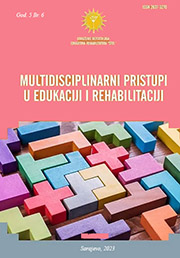COMPARATIVE ANALYSIS OF VISUAL ACUITY AND BINOCULAR VISION BEFORE AND AFTER STRABISMUS SURGERY
COMPARATIVE ANALYSIS OF VISUAL ACUITY AND BINOCULAR VISION BEFORE AND AFTER STRABISMUS SURGERY
Author(s): Saša Koca, Meliha HalilbašićSubject(s): Health and medicine and law
Published by: Udruženje defektologa, edukatora-rehabilitatora (STOL)
Keywords: binocular vision; visual acuity; strabismus;
Summary/Abstract: Binocular vision is the ability to focus on an object with both eyes simultaneously in order to create a single visual image. Although lack of binocular function is normal in infants, it is not the case in children and adults as it is necessary to have a good depth perception. Aim of this paper was to showcase postoperative binocular vision results after strabismus surgery. For that purpose, we utilized medical records of 72 patients who had their first strabismus surgery done at the Clinic for Eye Diseases in Tuzla between February 2017 and February 2023. Pre-operative deviation, diagnosis, binocular function, visual acuity and age were analyzed as factors that influence the success of the surgery. In order to assess set goals of the research, Chi square test, Wilcoxon matched-pairs signed-rank test and logistic regression analysis with forced entry were used. Patients were divided into two groups, first with esotropy and the second with exotropy, both groups were under the age of 7. Surgery success rate for respondents under the age of 7 was 67.1% and for the respondents over the age of 7 was 81.1% and no statistically significant improvement in visual acuity was observed. Success rate of achiving binocular vision, after strabismus surgery, was 49.3for esotropy and 97.3 fir exotropy. Factors that influenced success rate were pre-operative deviation and age group.
Journal: Multidisciplinarni Pristupi u Edukaciji i Rehabilitaciji
- Issue Year: 5/2023
- Issue No: 6
- Page Range: 29-38
- Page Count: 10
- Language: English

